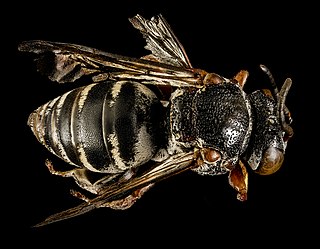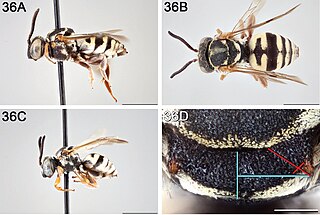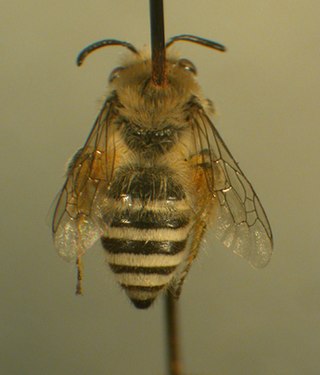
The genus Colletes is a large group of ground-nesting bees of the family Colletidae. They occur primarily in the Northern Hemisphere. They tend to be solitary, but sometimes nest close together in aggregations. Species in the genus build cells in underground nests that are lined with a cellophane-like plastic secretion, a true polyester, earning them the nickname polyester bees.

The northern colletes is a species of bee within the genus Colletes. Northern colletes are solitary bees, though females may nest in what are termed aggregations – sites where the bees nest close together, but do not form colonies as social bees do. They nest underground in soft soil, digging burrows up to 20 times their body length. It is often to be found nesting in coastal sand dunes and, on Hebridean islands, machair.

Epeolus pusillus is a species of cuckoo bee in the family Apidae. It is found in the United States and Mexico. The species is a parasite of Colletes compactus and Colletes ciliatoides.
Acmaeodera bryanti is a species of metallic wood-boring beetle in the family Buprestidae. It is found in North America.
Colletes susannae is a species of hymenopteran in the family Colletidae. It is found in North America.
Colletes slevini, or Slevin's cellophane bee, is a species of hymenopteran in the family Colletidae. It is found in North America.
Colletes howardi is a species of hymenopteran in the family Colletidae. It is found in North America.

Epeolus lectoides, the cuckoo bee, is a species of cuckoo bee in the family Apidae. It is found in North America. Hosts include Colletes latitarsis and Colletes nudus.
Saropogon bryanti is a species of robber flies.

Epeolus compactus is a species of cuckoo bee in the family Apidae. It is found in the United States and Mexico. It is a parasite of Colletes kincaidii, with females laying eggs in the host species' nest.

Colletes solidaginis, the goldenrod cellophane bee, is a species of hymenopteran in the family Colletidae. It is found in North America.

Colletes hyalinus is a species of hymenopteran in the family Colletidae. It is found in North America.
Colletes longifacies is a species of hymenopteran in the family Colletidae. It is found in North America. The species is one of five from the family Colletidae that are endemic to the state of Florida. The species occurs in North-Central Peninsular Florida and the Panhandle.
Efferia bryanti is a species of robber flies in the family Asilidae.
Colletes fulgidus is a species of hymenopteran in the family Colletidae. It is found in North America.
Colletes aberrans is a species of hymenopteran in the family Colletidae. It is found in North America.
Colletes tectiventris is a species of hymenopteran in the family Colletidae. It is found in North America.

Colletes kincaidii, or Kincaid's cellophane bee, is a species of hymenopteran in the family Colletidae. It is found in North America.

Epeolus bifasciatus is a species of cuckoo bee in the family Apidae. It is found in Central America and North America. It is a parasite of Colletes latitarsis.
Colletes ochraceus is a species of hymenopteran in the family Colletidae. It is found in North America.








